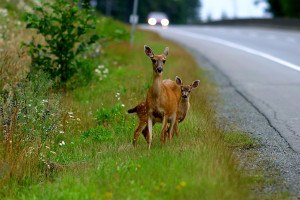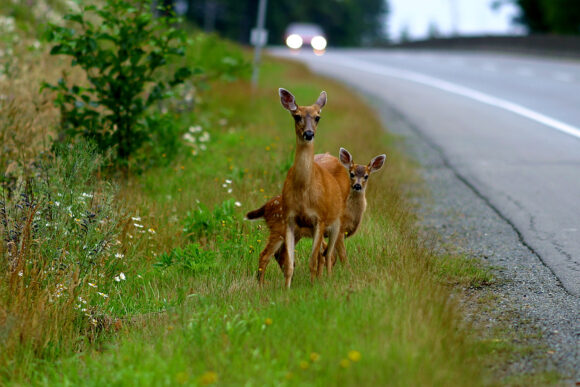It’s October and deer will soon be on the move, if they are not already.
 Deer often prance across the street without looking both ways and sometimes stop in the middle of the road with the dreaded “deer in the headlights” expression, resulting in the age old question, “Am I going to hit a deer or is the deer going to hit me?”
Deer often prance across the street without looking both ways and sometimes stop in the middle of the road with the dreaded “deer in the headlights” expression, resulting in the age old question, “Am I going to hit a deer or is the deer going to hit me?”
Kansas Highway Patrol, along with the Kansas Department of Transportation, Kansas Department of Wildlife, Parks and Tourism and AAA, have provided what to do if people see a deer or people who are unfortunate and hit a deer.
According to data provided by the KHP which documented vehicle-deer collisions from 2006 through 2017, beginning around October and through November there is an increase in vehicle-deer collisions, the Pittsburg Morning Sun reported.
The incidents spike mid-November which is when the rut, or mating season for deer peak. The deer are also on the move to seek shelter and better habitats as crops are harvested and leaves fall. “The deer population has stabilized over the last six years, so areas that have had deer likely still have them,” said Levi Jaster, big game coordinator at the Kansas Department of Wildlife, Parks and Tourism. “This time of year, young animals are dispersing to find new places to live and breeding season is approaching.
“More animals on the move mean more of them will be crossing roads, so be extra cautious in areas with good deer habitat.” According to KDOT in a release, “10,226 (17 percent) of the 58,834 vehicle crashes reported in 2017 were deer-related (crashes in which a deer and vehicle actually collided or the presence of a deer was a contributing circumstance). Crashes involving deer occur in every part of the state throughout the year.”
In 2017 there were 170 total vehicle-deer collisions in Crawford County. There were eight injuries and zero fatalities and 162 people reported “personal damage.”
“As we approach the fall season, the frequency of car-deer accidents tend to increase dramatically,” Pittsburg Police Lt. Tim Tompkins said. “The police department would like to remind drivers to be mindful of deer being on the move crossing roadways and to be alert to roadside movement both on our rural highways and within the city limits.”
AAA Kansas said in the release that in addition to the human injuries and loss of life, the collisions can cause significant vehicle damage, and if not properly insured it can cost upward of $4,500 per claim.
According to the release, if deer appear alongside the road the Kansas Highway Patrol “cautions drivers to refrain from making exaggerated maneuvers to avoid a deer in the road, lest a bad situation become even worse.”
“If you are unfortunate enough to have a deer enter the highway in front of your car, it is best to hit the animal and not swerve to avoid it,” KHP’s Lt. Adam Winters said. “Often, we find more serious crashes occur when you swerve to miss the deer, potentially losing control of your vehicle, leaving the road or veering into oncoming traffic.”
The agencies recommend the following to help motorists avoid crashes with deer:
- Be especially watchful at dawn and dusk, when deer are more active.
- If you see one deer, watch for others, as they seldom travel alone.
- Reduce speed and be alert near wooded areas or green spaces, such as parks and golf courses, and near water sources such as streams and ponds.
- Deer crossing signs show areas where high numbers of vehicle/deer crashes have occurred in the past.
- Use bright lights when there is no oncoming traffic and scan the road ahead of you to watch for deer.
- Don’t swerve to avoid hitting a deer – the most serious crashes sometimes occur when motorists swerve and collide with another vehicle or run off the road and hit an obstacle. Always wear a seatbelt and use the appropriately-fitted child safety seats – they are your best defense should you be involved in a crash.
- Honk your horn with one long blast. A long blast on your horn may frighten large animals, such as deer, away from your vehicle. The Insurance Information Institute (I.I.I.) advises against relying on devices such as deer whistles and reflectors, which have not been proven to reduce collisions with animals.
If people do strike a deer, here are some additional tips:
- Slow down, move your vehicle to the shoulder if possible, and call for law enforcement. KHP dispatch can be reached at (asterisk)47, Kansas Turnpike at (asterisk)KTA, and local law enforcement at 911. Make sure you tell the dispatcher if the animal or your vehicle is still in the road.
- If you hit a deer or other animal, do not worry about removing the animal. Law enforcement can remove the animal from the road when they arrive. Don’t go near a wounded animal. A frightened and wounded animal can be unpredictable.
- Turn on your hazard lights and remain buckled up inside your vehicle. You are more protected this way, should a secondary crash occur.
- If you must be outside your vehicle, make sure it is as far off the road as possible, and do not stand between your vehicle and another one. Keep children buckled, and in car seats in the vehicle. Be vigilant and watch traffic.
- Anyone involved in a vehicle-deer crash resulting in personal injury or property damage that totals $1,000 or more is required to immediately report the crash to the nearest law enforcement agency. Failure to report any traffic crash is a misdemeanor and may result in suspension of driving privileges.
- A salvage tag is required to remove a deer carcass, or any part of the carcass, from the crash site. Tags can be issued by KHP troopers, sheriff’s deputies, or KDWPT game wardens.
Was this article valuable?
Here are more articles you may enjoy.


 Cyber Breach Affected 750,000 Canadian Investors, Regulator Says
Cyber Breach Affected 750,000 Canadian Investors, Regulator Says  First Brands Judge Approves Examiner to Probe Fraud Allegations
First Brands Judge Approves Examiner to Probe Fraud Allegations  Allianz Built An AI Agent to Train Claims Professionals in Virtual Reality
Allianz Built An AI Agent to Train Claims Professionals in Virtual Reality  US Lawmaker Unveils Bill Requiring Manual Car-Door Releases
US Lawmaker Unveils Bill Requiring Manual Car-Door Releases 